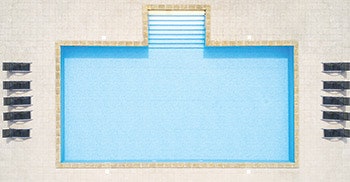They are among the most common components on all types of pools, spas, fountains and other man-made bodies of water. The humble skimmer is truly ever present — so much so, in fact, that it predates pumps and filters. Back in the early 1900s when the modern pool industry was still in its infancy, there were no recirculation systems; water generally entered the pool at or near the bottom and exited through "scum gutters" that were essentially massive skimmers.
In terms of what skimmers do and how they do it, things haven't really changed much since then. There are new designs meant to enhance skimming efficiency and convenience, but they all do essentially the same work of removing debris from the water's surface.
Knowing how to use skimmers effectively remains a fundamental aspect of pool and spa design — and something that many people in the industry simply take for granted.
WHY SO IMPORTANT
Skimmers are crucial to pool and spa function for one very simple reason: Debris and contamination almost always enter through the water's surface, where it floats before sinking. In commercial pools, the top layer of water often contains significant amounts of sunscreen, lotion and other compounds introduced by high bather loads. In residential pools, contamination usually consists of dirt and debris from the surrounding landscape. Either way, filtering that top ½-inch of water is the first line of defense for water quality.
Despite that essential function, skimmers are often ignored and underused. Even in new construction, it's common to find pools with too few skimmers that may or may not be placed in the best locations around the pool's perimeter. That deficiency becomes a significant issue for service companies and property owners alike.
"When you look at public pools and spas, all the body oils and suntan lotion and the stuff we want removed and treated, it all floats," says Steve Barnes, director of science and compliance for AquaStar, which manufactures skimmers and other pool fittings in Ventura, Calif. "That's why in high-use pools and spas, skimming is the most important aspect of maintenance. In residential pools, it's more about debris such as leaves and dust, but it all floats and should be removed as quickly as possible."
According to Steve Kenny, president of SRK Pool Solutions, a service and construction firm based on Long Island, N.Y., under-designed plumbing systems with inadequate skimming
action are a common obstacle his service technicians face.
RELATED: Skimmer Replacement, Part 1
"Skimmers are so commonplace that it's easy to take them for granted," he says. "The irony is skimmers are one of the most important parts of the pool when it comes to maintaining superior water quality. The idea is to break that surface tension and get the top ½ inch of contaminated water into the skimmer baskets, the filter, and chemical treatment systems," he says. "When you don't have adequate skimming action, you can see the scum line form all the way around the pool, and the water quality deteriorates. Either it goes into the skimmer or it stays in the water, where it either eventually sinks or continues to muck up the surface. The water becomes much more difficult to maintain, if not impossible. Skimmers are that important."
While skimmers are often overlooked, some builders are beginning to realize just how big a role this small fitting plays in the pool.
"Lately there have been more builders paying attention to skimmers," says Joshua Hoots, associate product manager for Hayward Industries. "They are such an important part of the pool system, and on most pools the skimmer is going to stay with the pool longer than any other piece of equipment. When it's set in place in concrete, you're going to do everything you can to make sure it stays there, because although it's very low cost when you install it, skimmers are one of the higher-cost products to replace. All of that is why there are some builders who realize one of the ways they can differentiate themselves is by doing a better job with skimmers and hydraulics overall."
HOW MANY & WHERE
One of the most fundamental aspects of skimmer use is simply making sure you have enough of them. According to most standards and recommendations, public pools require a skimmer for every 500 square feet of surface area, while residential pools require one for every 800 square feet.
"In other words, if you have a 1,200-square-foot residential pool, you'd need two skimmers; a commercial pool that size would need three," Barnes says. "If you're in a heavy debris environment or working on a pool with an odd shape, additional skimmers may be required."
For his part, Kenny prefers to use more than the bare minimum. "It's just my opinion," he says, "but when I go to a pool that's 20 by 40 and there's two skimmers and two return lines, that's grossly under-designed. Depending on the situation, with that 40-by-20 pool I might use four or even six skimmers. We've remodeled pools and added additional skimmers and re-plumbed them so they have balanced flow; it's doable but it's so much better and less expensive when builders do it right in the original construction."
While calculating an adequate number of skimmers based on square footage is helpful, there can be much more that goes into an effective layout. "The shape of the pool really plays into it," Hoots says. "For most rectangular backyard pools, two skimmers will be enough, probably one each side. But when you get into pools with more-complex shapes, it's very common to use additional skimmers by features like step outs, or, in an L-shaped pool, in places you'd expect to find dead spots. It's very design-dependent."
Skimmer placement can also be dependent on environmental factors such as wind. "In the Southwest desert, for example, you have strong prevailing winds and the debris is going to typically be pushed in one direction," Hoots says. "You want to position the skimmers so that they capture the debris being pushed toward them. You certainly don't want to fight nature but rather use it to the pool's advantage.
"In a way, that's similar to positioning returns so they push water toward the skimmer, whether it's in a racetrack fashion or directly toward the skimmer from across the pool."
 For a pool this size, Kenny would place four or even six skimmers for optimal operation.
For a pool this size, Kenny would place four or even six skimmers for optimal operation.
PROPER FLOW RATES
Ensuring skimmers operate within specified flow rates is another key. On the most basic level, according to Barnes, skimmer systems should be designed to handle 100 percent of the pool's desired turnover rate, which is also true of out suction outlets such as main drains. In effect, he says, pools should be designed with 200 percent suction capacity between the skimmers and the drains.
In practice, however, pools and spas should operate with approximately 2/3 or more of the suction being handled through the skimmers. "All pool codes require that you design your skimming capacity for 100 percent of the desired flow and turnover rate," Barnes says. "And likewise, your drain systems should be sized for 100 percent of the flow. Where you operate the system is very different."
Flow through the individual skimmers depends on the plumbing size and skimmer design. "The flow rating is based on the minimum operating level and cannot exceed 6 feet per second. It also can't suck air into the system at the minimum operating level," Barnes says. "Typically, with 2-inch pipe sizing, skimmers start to suck air at 60 gallons per minute when they're operating on the low water level."
RELATED: Skimmer Replacement, Part 2: In With the New
Equally important is how they are plumbed. "Are you going to put them on a 3-inch trunk that runs around the entire pool and equalizes the flow, or are you going to bring them back to the equipment pad in individual home runs?" Kenny says. "We always try to split it perfectly so that all skimmers have equal flow. You see some builders that plumb them in sequence, which is the wrong way to do it because the first skimmer will have much more flow than the second skimmer and so on down the line. If you have too much flow through a skimmer or not enough, it compromises the function and none of them end up working. It's a big mistake that can make the pool impossible to maintain."
Barnes agrees: "One of the biggest problems we have is that installers don't understand hydraulics," he says. "The worst example we've seen was a pool where they had 15 skimmers all plumbed in sequence, all on 2-inch plumbing, which means each skimmer has less flow than the one before it. That was a bust-out-the-deck kind of a problem.
"So, to summarize, you need to select the right number of skimmers, put them in the right place and plumb them so that they all have balanced flow rates."
BEING EQUAL
One of the more confusing aspects of skimmer use is the role of the equalizer lines and float valves and how they relate to water level.
Skimmers typically require 4 inches of "travel" across the weir, or 3 inches for pools with auto-leveling systems. That means the water level will be approximately halfway up the skimmer opening, where it flows over the weir.
The weir serves three basic functions:
(1) It prevents debris from flowing back out into the pool once it's captured, essentially functioning like a check value.
(2) It moderates the flow into the skimmer as water rises and falls so that it receives enough water to function, but not so much that it floods.
(3) It ensures that the top ½ inch of water flows into the skimmer.
When the water level drops below the skimmer opening due to splash out, evaporation or leaks, that's when the equalizer line, float valve and auto-fill systems come into play. "A lot of builders ignore the equalizer lines, which are hugely important," Kenny says. "If the water level drops and isn't flowing into the skimmer, and especially if there's no auto-fill system, the pump will start pulling air in through the skimmer — and then you run into a host of possible problems. You always want to maintain the proper operating level, but there are going to be times with splash out, or in the case of a leak, where the level will drop. The auto-fill and the equalizer lines are there to protect the system. It's like everything else in the pool system: All the pieces hold hands and work together."
"Without a float valve and without an equalizer line, the pump has no option but suck in air," Hoots adds. "The water leveler does help and the equalizer line becomes somewhat less critical, but there can always be situations where you're losing water faster than it's being replaced. Even if it's a very short period of time, you still want to protect the system with an equalizer line and a float valve."
Things get a bit more complicated in commercial pools, where concerns over entrapment and other safety issues have limited or even outlawed the use of equalizer lines. "Equalizer lines have been outlawed in public pools in some places because they allow the pool to operate below the water level," Barnes says. "When the level is down that makes it harder to get in and out of the pool and the water level is lower than required, which creates a diving hazard. So, the scenario where the equalizer is of benefit are direct violations of that pool being open. If you do have an equalizer line, it has to have a float valve because when the water level drops, the pump is going to suck air."
|
|












































